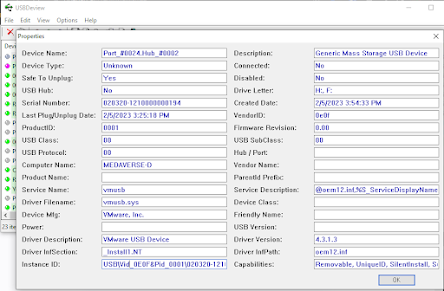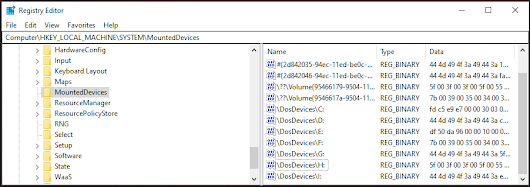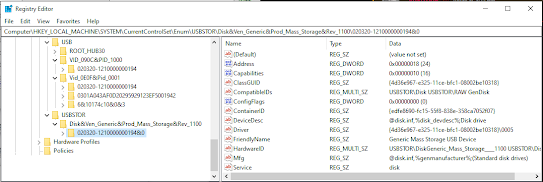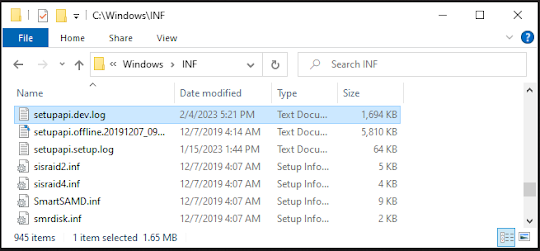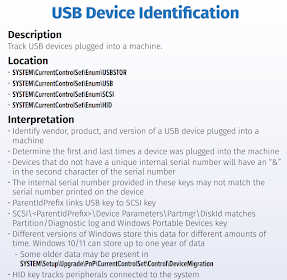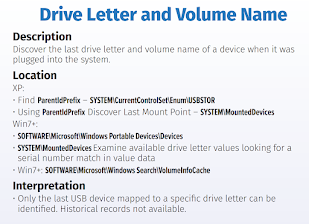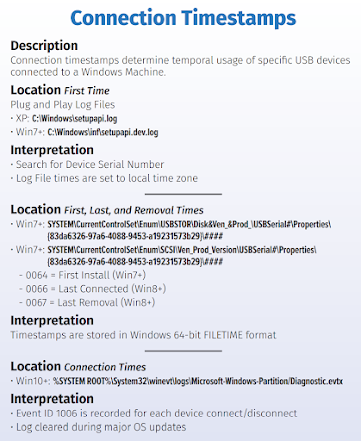Windows USB Connection Analysis

USB connections are a commonly used method for transferring data between computers and other electronic devices. In Windows, the use of USB connections can affect the registry in several ways, including within the registry are the USB, USBSTOR and MountPoints keys. In this post, we’ll explore the connection between USB Mountpoints and the setupapi.dev.log, and provide examples of both normal and malicious use cases.
USB Forensics Overview
USB device forensics involves analyzing multiple Windows artifacts to track USB device usage, including:
- Registry Keys: USB, USBSTOR, and MountedDevices
- Log Files: setupapi.dev.log and setupapi.app.log
- Event Logs: System and Security event logs
- File System: LNK files and recent document lists
Registry Locations
USB Device Registry Keys
The primary registry locations for USB forensics are:
HKEY_LOCAL_MACHINE\SYSTEM\CurrentControlSet\Enum\USB
HKEY_LOCAL_MACHINE\SYSTEM\CurrentControlSet\Enum\USBSTOR
HKEY_LOCAL_MACHINE\SYSTEM\MountedDevices
MountedDevices Registry
The MountedDevices registry key contains information about all mounted storage devices:
This key maps:
- Volume GUIDs to physical device identifiers
- Drive Letters to device signatures
- Device Serial Numbers to mount points
USBSTOR Registry Analysis
The USBSTOR key provides detailed information about USB storage devices:
Key information includes:
- Vendor ID: Manufacturer identifier
- Product ID: Device model identifier
- Device Serial Number: Unique device identifier
- Device Class: Type of USB device
Each device entry contains:
- First Installation Time: When device was first connected
- Last Connection Time: Most recent connection timestamp
- Device Properties: Hardware characteristics and capabilities
Setup API Device Log Analysis
The setupapi.dev.log file provides detailed information about device installation and connection events:
The log contains:
- Device Installation Events: When devices are first recognized
- Driver Installation: Driver loading and configuration
- Connection Timestamps: Precise connection and disconnection times
- Error Messages: Installation failures or device conflicts
Log File Locations
C:\Windows\inf\setupapi.dev.log
C:\Windows\inf\setupapi.app.log
These logs provide:
- Chronological device activity
- Device identification details
- Installation success/failure status
- Driver compatibility information
Normal Use Cases
Legitimate USB Activities:
- File Transfers: Moving documents between systems
- Backup Operations: Regular data backup to external drives
- Software Installation: Installing software from USB media
- Peripheral Devices: Keyboards, mice, printers, cameras
Business Environment Usage:
- Employee file transfers for legitimate work
- IT administration and system maintenance
- Approved backup and storage operations
- Authorized software installations
Malicious Use Cases
Data Exfiltration:
- Unauthorized File Copying: Stealing sensitive documents
- Database Dumps: Extracting large datasets
- Intellectual Property Theft: Copying proprietary information
- Personal Data Harvesting: Stealing customer or employee data
Malware Introduction:
- USB-Based Malware: Introducing viruses or trojans
- Autorun Exploits: Exploiting autorun functionality
- Lateral Movement: Moving malware between air-gapped systems
- Persistence Mechanisms: Installing backdoors via USB
Anti-Forensics:
- Evidence Destruction: Using USB tools to wipe evidence
- Registry Cleaning: Removing traces of USB activity
- Log File Manipulation: Altering or deleting device logs
- Timestamp Modification: Changing file modification times
Forensic Analysis Techniques
Timeline Construction
Registry Timestamp Analysis
- Extract first installation times
- Identify last connection times
- Correlate with user activity
Log File Correlation
- Parse setupapi.dev.log entries
- Match device events with registry data
- Build comprehensive timeline
Cross-Artifact Analysis
- Correlate with Event Logs
- Analyze LNK files for USB access
- Review recent document lists
Device Identification
- Vendor/Product ID Lookup: Identify specific device models
- Serial Number Tracking: Follow individual device usage
- Capacity Analysis: Determine storage device sizes
- Connection Pattern Analysis: Identify regular vs. anomalous usage
SANS USB Analysis References
Investigation Best Practices
Data Collection
- Registry Hive Extraction: Capture SYSTEM and SOFTWARE hives
- Log File Preservation: Collect setupapi logs and Event Logs
- Timeline Documentation: Create comprehensive timeline of USB activity
- Cross-Reference Analysis: Correlate multiple data sources
Analysis Methodology
- Device Enumeration: Catalog all USB devices ever connected
- Timeline Analysis: Map device usage patterns over time
- Anomaly Detection: Identify unusual device connection patterns
- Data Correlation: Cross-reference with other forensic artifacts
Reporting Considerations
- Document all USB devices and connection times
- Highlight suspicious or policy-violating activities
- Provide context for legitimate business usage
- Correlate findings with other investigative evidence
Limitations and Challenges
Data Persistence
- Registry entries may be overwritten
- Log files have size limitations
- Some data may be cleared by system maintenance
- Anti-forensics tools can remove traces
Technical Limitations
- USB hub connections may complicate analysis
- Virtual machine USB redirection affects tracking
- Some USB devices may not generate full registry entries
- Encrypted devices may limit analysis capabilities
Conclusion
Windows USB connection analysis provides crucial insights into data transfer activities and potential security incidents. The combination of registry analysis, log file examination, and timeline correlation enables investigators to:
- Track unauthorized data exfiltration attempts
- Identify malware introduction vectors
- Establish patterns of legitimate vs. suspicious USB usage
- Provide concrete evidence of device connections and usage
Effective USB forensics requires systematic analysis of multiple data sources, careful timeline construction, and thorough understanding of Windows USB device management. This analysis capability is essential for data loss prevention investigations, insider threat detection, and comprehensive incident response activities.
